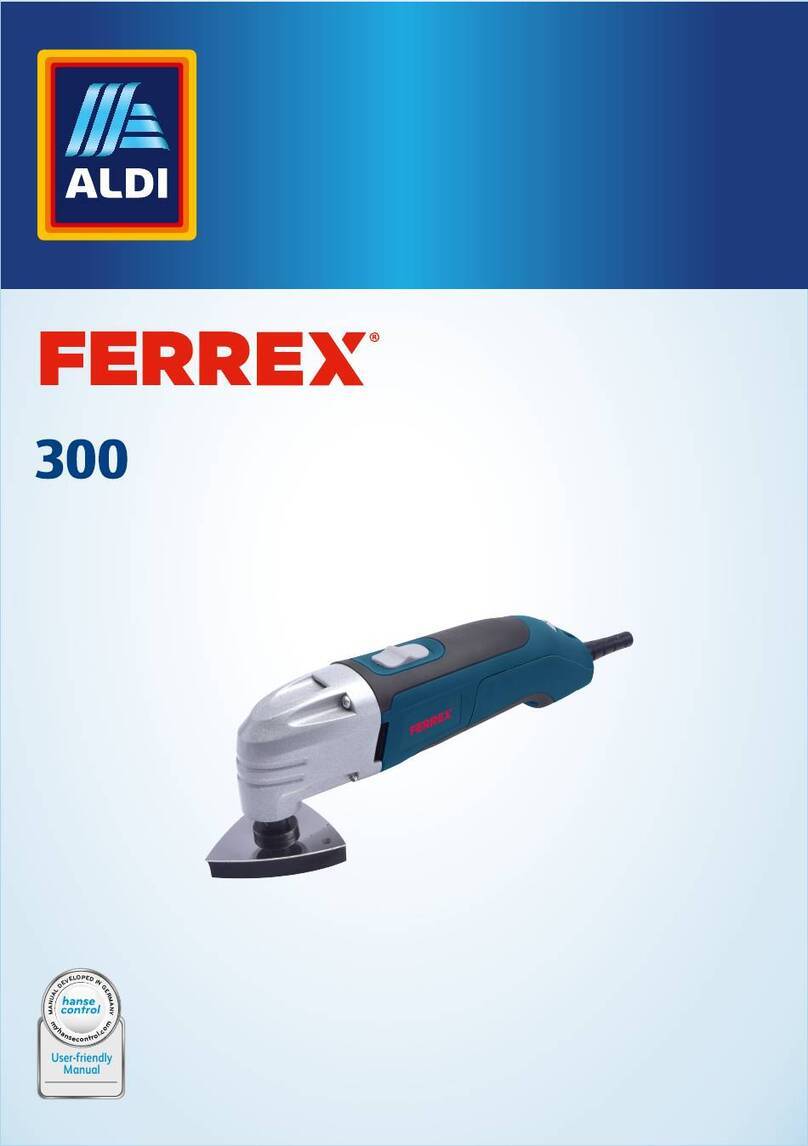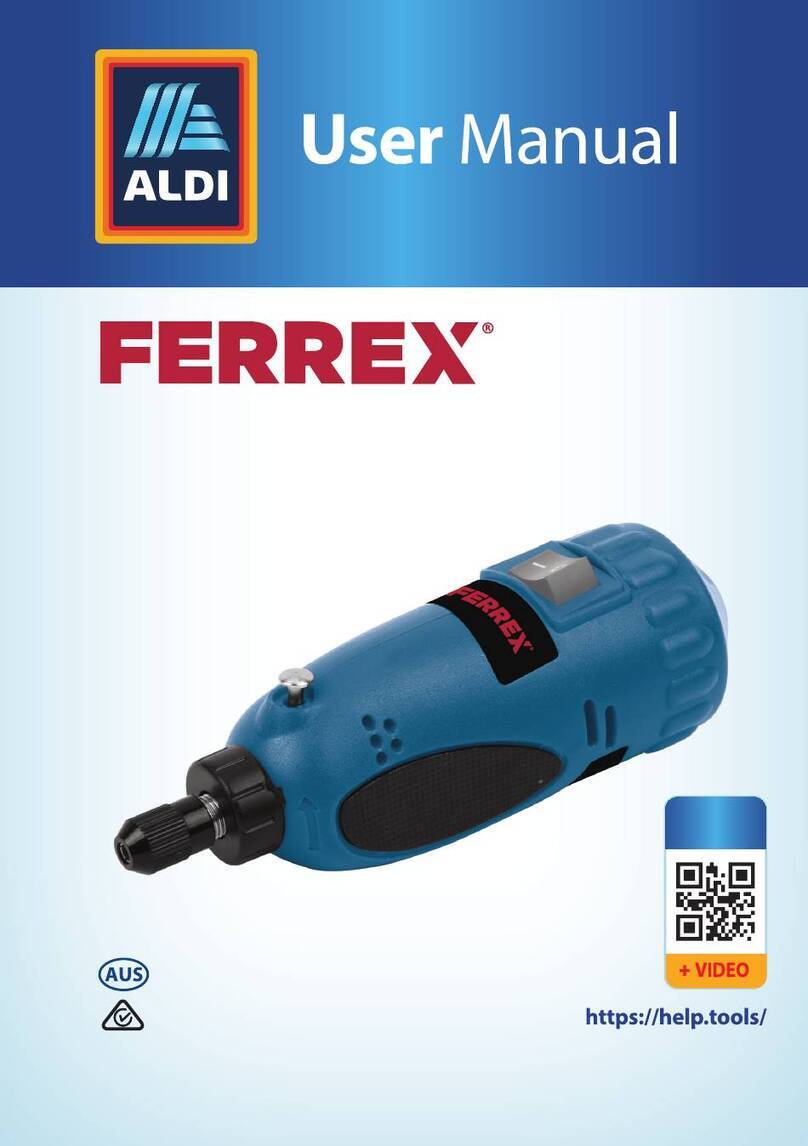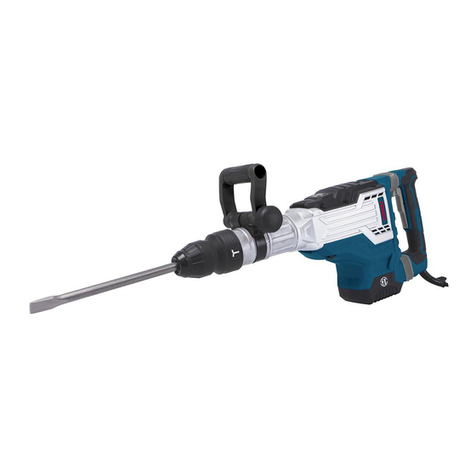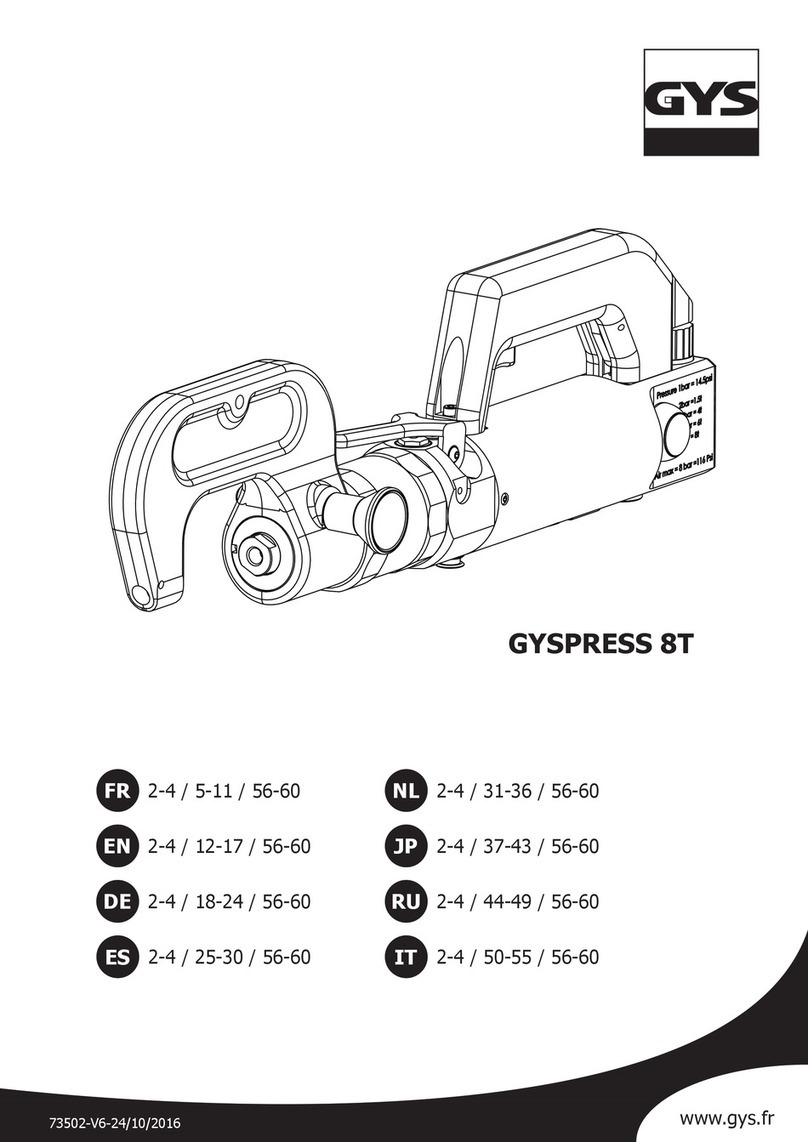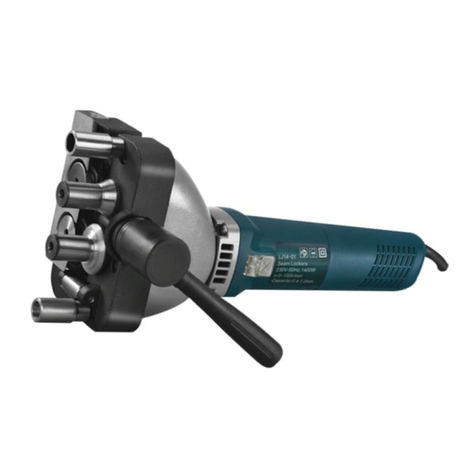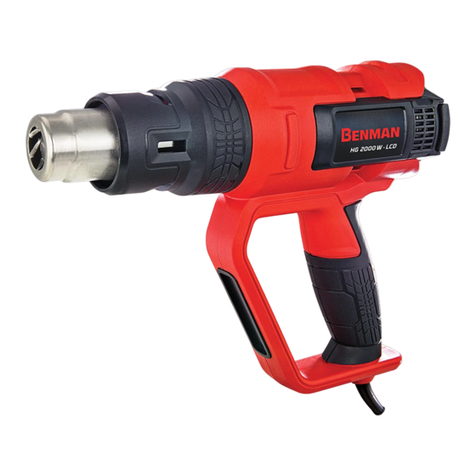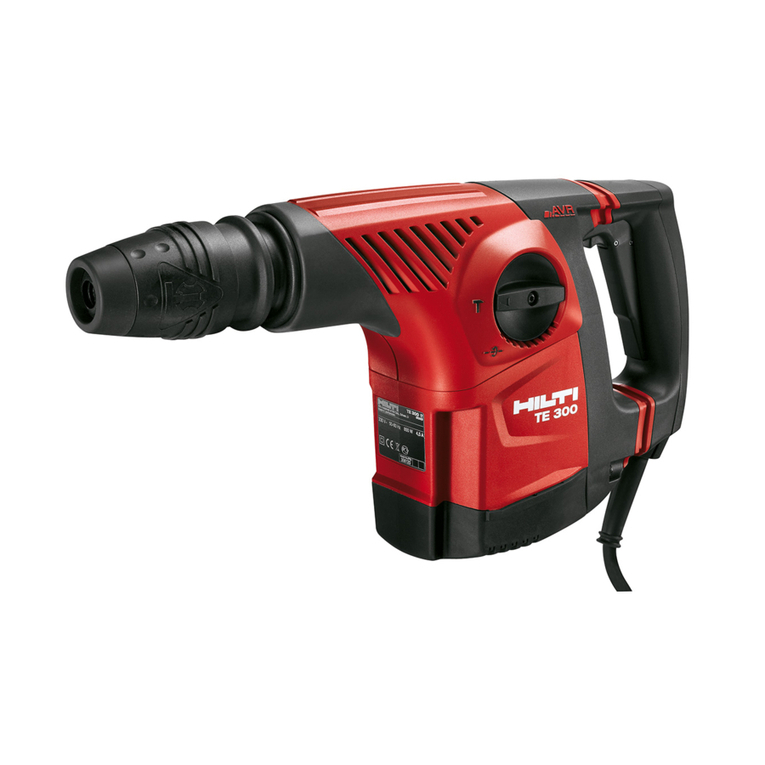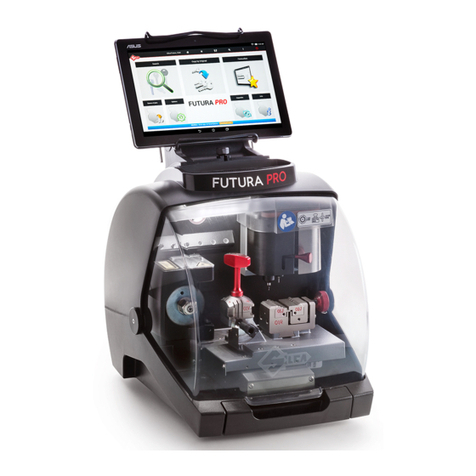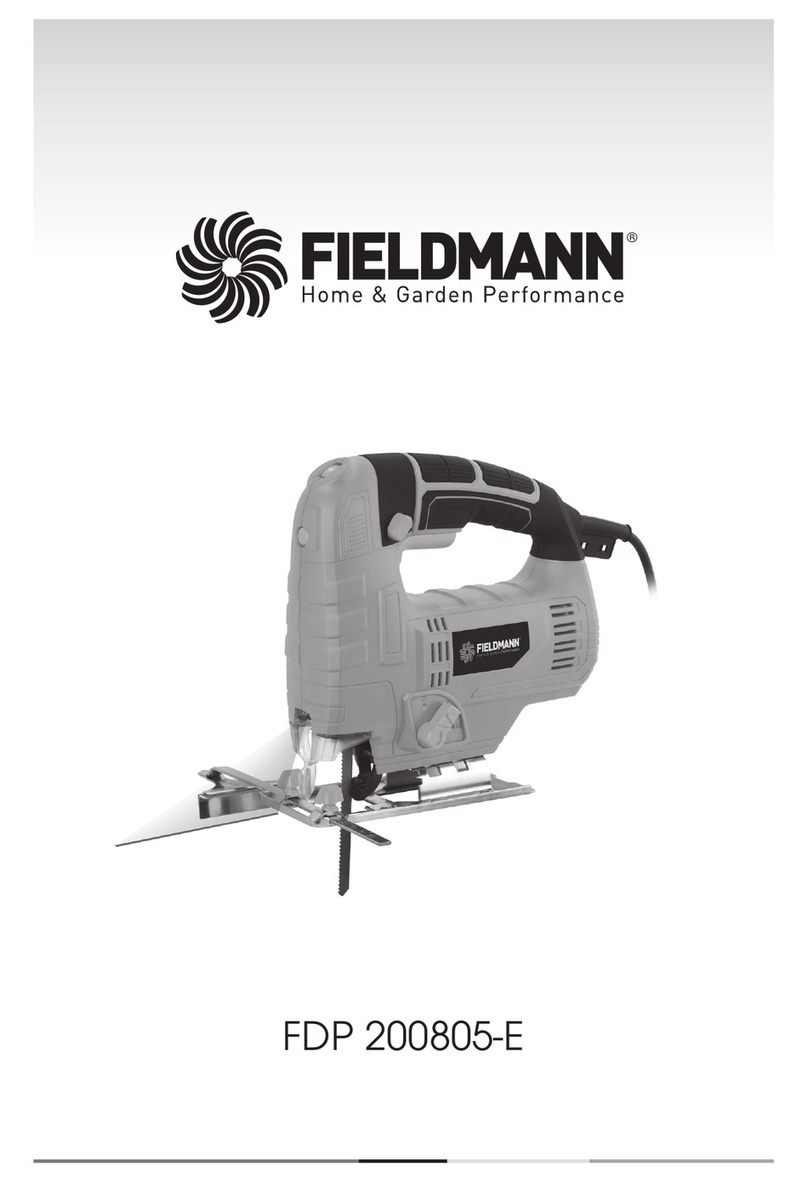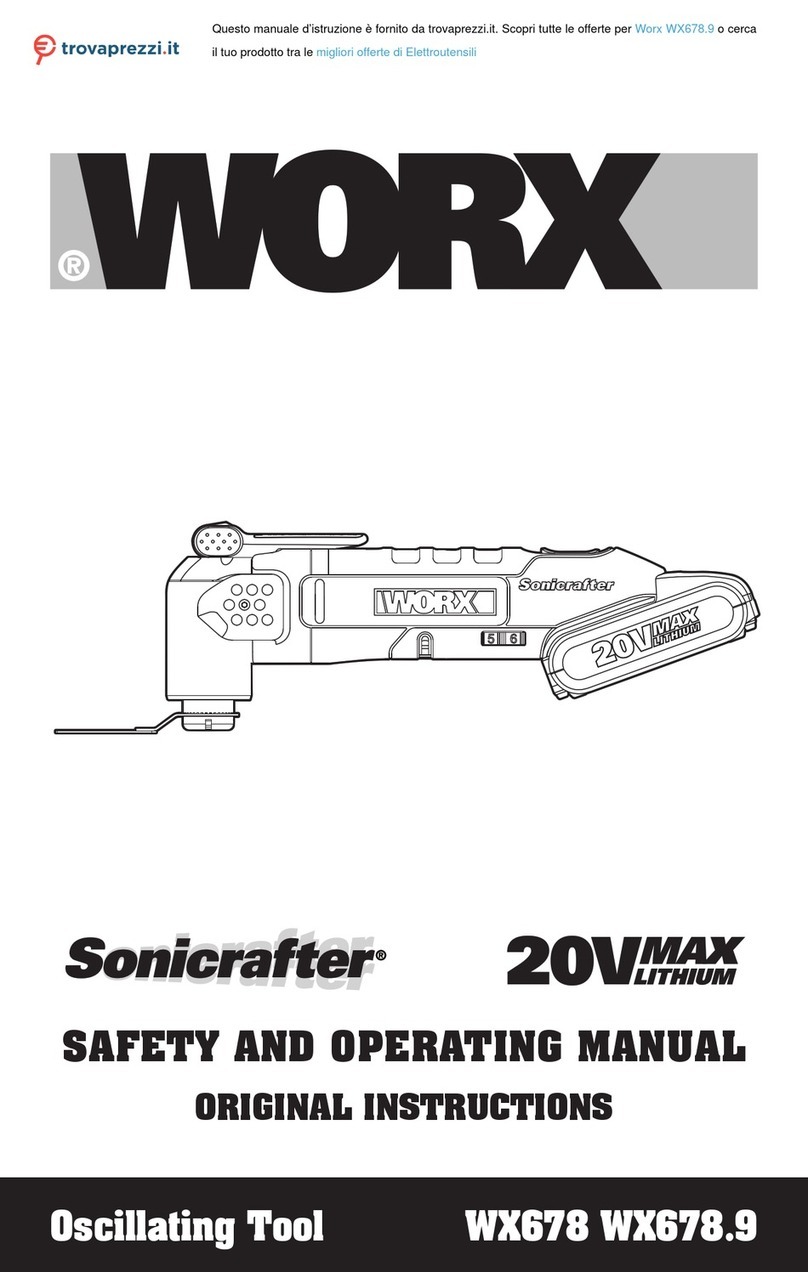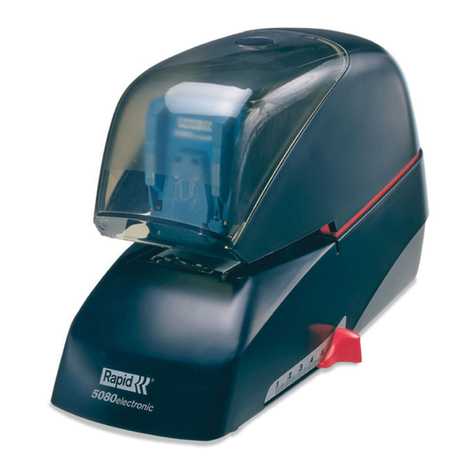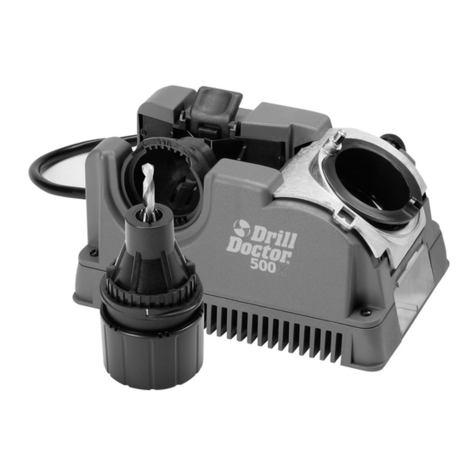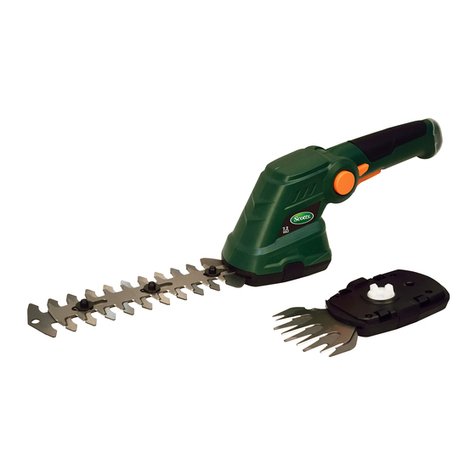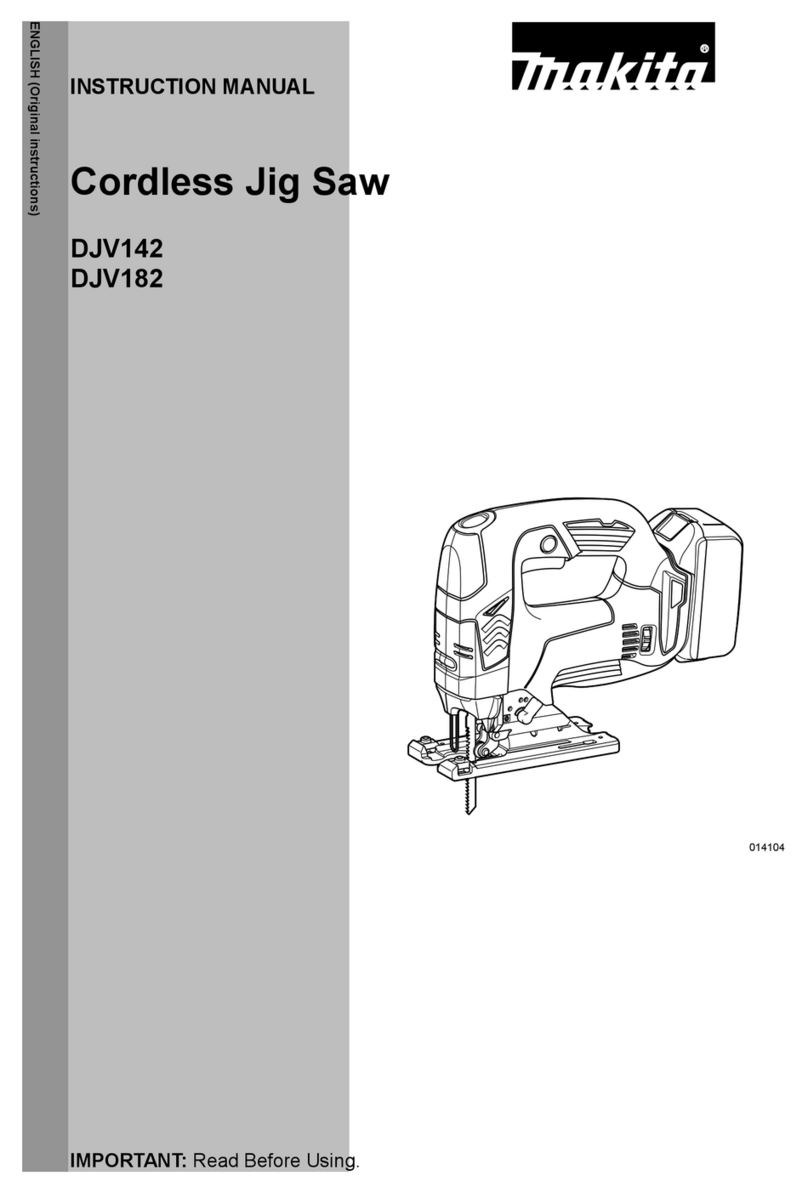FERREX FAPS 20-I User manual

20 V LI-ION CORDLESS
JIGSAW
User Manual
ID: #05007
m
y
h
a
n
s
e
c
o
n
t
r
o
l
.
c
o
m
M
A
N
U
A
L
D
E
V
E
L
O
P
E
D
I
N
G
E
R
M
A
N
Y
User-friendly
Manual
Original instructions

Package contents........................................................................ 3
Components .......................................................................................6
General information.................................................................... 7
Reading and storing the user manual ........................................... 7
Explanation of symbols .................................................................... 7
Safety ...........................................................................................8
Explanation of notes .........................................................................8
Proper use...........................................................................................8
Residual risks......................................................................................9
General safety notes for power tools..............................................9
Using and handling the power tool...............................................11
Cordless tool use and care...............................................................12
Preparation ............................................................................... 14
Protective cover ............................................................................... 14
Attaching the sliding shoe ............................................................. 15
Inserting/changing the saw blade............................................... 15
Adjusting the saw shoe for mitre cuts.......................................... 16
Dust blower function........................................................................17
Attaching the shaving/chip extraction system ...........................17
Attaching the parallel guide.......................................................... 18
Using the rechargeable battery.................................................... 18
Charging the rechargeable battery ............................................. 19
Inserting and removing the rechargeable battery ................... 19
Operation................................................................................... 19
Setting the stroke rate .................................................................... 19
Setting the pendulum stroke ........................................................20
Switching the product on and off ................................................. 21
Sawing............................................................................................... 21
Sawing out sections ........................................................................ 22
Performing plunge cuts .................................................................22
Troubleshooting........................................................................ 23
Cleaning and maintenance....................................................... 23
Storage ...................................................................................... 24
Transport ................................................................................... 24
Replacing the carbon brushes ......................................................24
Technical data ........................................................................... 25
Rechargeable battery and charger information........................25
Noise/vibration information .................................................... 26
Disposal...................................................................................... 28
Disposing of the packaging ...........................................................28
Disposing of the product ................................................................28
Declaration of conformity......................................................... 29
Contents

3
Package contents
Dok./Rev.-Nr. 197376_20190708
1
2
3
1
12
2 3 4
6
13 12 11 10 9 8
5
7
A
Package contents

4
Package contents
D E
C
15 16 17
B
14
7
18 19

5
Package contents
1
2
3
F
1
2
3
G
13
15
1
2
3
H
1
2
3
I
1
2
3
J K
13 9
10
12
8
7
17
11
16
7

6
Package contents
Components
1Dial for the stroke rate control
2Locking key for On/Off switch
3On/Off switch
4Handle
5Battery holder
6Sliding switch for dust blower function
7Saw shoe
8Sliding shoe
9Pendulum stroke adjustment
10 Guide roller
11 Saw blade holder
12 Locking screws (Parallel guide)
13 Protective cover
14 Locking lever for saw shoe
15 Saw blade
16 Parallel guide
17 Adapter for shaving/chip extraction system
18 LED light
19 Directional guide

General information
7
General information
Reading and storing the user manual
This user manual accompanies this 20 V Li-ion cordless Jigsaw (referred
to below only as the ‘product’). It contains important information on
safety, usage and care.
Before using the product, read the user manual carefully. Pay particular
attention to the safety instructions and warnings. Failure to comply with the
instructions in this user manual may result in severe injury or damage to the product.
You must comply with applicable local or national regulations concerning the use of
this product. Keep this user manual in a safe place for future reference. Make sure to
include this user manual when passing the product on to third parties.
This user manual can be downloaded in PDF format from our website at
www.conmetallmeister.de.
Explanation of symbols
The following symbols are used in this user manual, on the product or on the
packaging.
This symbol provides you with useful supplementary information on
assembly or use.
Declaration of conformity (see chapter ‘Declaration of conformity’):
Products marked with this symbol meet all applicable Community
regulations for the European Economic Area.
Read the user manual.
Wear protective goggles.
Wear a dust mask.
Wear ear protection.
Wear suitable secure footwear.

Safety
8
Wear suitable protective gloves.
Safety
Explanation of notes
The following symbols and signal words are used in this user manual.
WARNING!
Indicates a hazardous situation that, if not
avoided, could result in death or serious injury.
CAUTION!
Designates a dangerous situation that may result
in minor or moderate injury if not avoided.
NOTICE!
Warns of possible damage to property.
Proper use
The product is only suitable for private use – such as for hobbies or do-it-yourself
work – when undertaking the following:
• for cutting wood, metal, plastic,
• for straight cuts and cutting at angles (only for wood and plastics) with a mitre of
15°, 30° and a max. of 45°.
Any other applications are expressly prohibited and are deemed improper use.
This product does not come with a rechargeable battery or charger. These must be
bought separately: The product can be operated with the 20 V rechargeable battery
or with the 20/40V rechargeable battery available from Activ Energy®. Only use the
rechargeable batteries specified in the chapter ‘Technical data’ for the product. Do not
operate the product with rechargeable batteries from other manufacturers.
Neither the manufacturer nor the retailer can accept any responsibility for injury,
loss or damage caused by misuse of this product of any kind. Examples of misuse are
given in the following non-exhaustive list:
• using the product for other purposes other than those intended;
• failure to observe the safety instructions and warnings as well as the assembly,
operating, maintenance and cleaning instructions contained in this user manual;

Safety
9
• failure to comply with any regulations relating to accident prevention,
occupational health or safety, which specifically and/or generally apply to the use
of the product;
• use of accessories and spare parts not intended for the product;
• changes to the product;
• product repairs performed by parties other than the manufacturer or a qualified
professional;
• use of the product for commercial, artisan or industrial purposes;
• operation or maintenance of the product by persons not familiar with how to
handle the product and/or who are not aware of the related risks.
Residual risks
Despite proper use, inconspicuous residual risks cannot be completely ruled out.
The following risks may arise due to the design of the product:
• touching the exposed areas of the saw blade (cut injury);
• reaching into the rotating saw blade (cut injury);
• kickback of the work piece and parts of the work piece if used improperly;
• contact with projectile fragments of the saw blade in the event of breakage (cut
injury);
• loss of hearing if the required ear protection is not worn when working with the
device (hearing loss);
• contact with electrical current due to a defective or cut supply cable, motor
housing (electrical shock);
• emission of wood dust (injury to health);
• injury to health attributed to hand and arm vibration if the saw is not guided in a
controlled manner and maintained properly.
General safety notes for power tools
WARNING Read all the safety notes, instructions, illustrations and
technical details supplied with this power tool. Failure to follow the safety
notices and instructions may result in an electric shock, fire and/or severe
injury.
Keep all safety notes and instructions for future reference.
The term “power tool” used in the safety instructions refers to mains-operated
power tools (corded) and battery-powered power tools (cordless).

Safety
10
Work place safety
a) Keep your work area clean and well lit.
Cluttered or dark areas
invite accidents.
b) Do not work with the power tool in areas with a risk of explosion
where flammable liquids, gases or dusts are present.
Power tools
create sparks which may ignite the dust or fumes.
c) Keep children and other persons away from the power tool while
you are using it.
If you are distracted, you could lose control of the
power tool.
d)
This jigsaw is not intended to be used by children or persons with
impaired physical, sensory or mental abilities or those without
sufficient experience or knowledge.
Electrical safety
a) The connector plug for the power tool must fit in the socket. The plug
must not be modified in any way. Do not use any adapter plugs in
combination with power tools with protective earthing.
Unmodified
plugs and matching outlets will reduce the risk of electric shock.
b) Avoid body contact with earthed surfaces like pipes, heaters,
stoves and refrigerators.
There is an increased risk of electric shock
if your body is earthed or grounded.
c) Keep power tools away from rain or moisture.
Water entering a
power tool will increase the risk of electric shock.
d) Do not use the cord for improper purposes such as for carrying
the power tool, for hanging it up or for pulling or unplugging
it from the socket. Keep cord away from heat, oil, sharp edges
and moving parts.
Damaged or entangled cords increase the risk of
electric shock.
e) When operating a power tool outdoors, use only extension cords
that are suitable for outdoor use.
Use of a cord suitable for outdoor
use reduces the risk of electric shock.
f) If operating the power tool in a damp environment cannot be
avoided, use a RCD.
Use of an RCD reduces the risk of electric shock.
Safety of persons
a) Be careful, pay attention to what you are doing and approach
work with a power tool in a reasonable manner. Do not use

Safety
11
any power tool if you are tired or under the influence of drugs,
alcohol or medication.
A moment of inattention while operating
power tools may result in serious personal injury.
b) Wear personal protective gear and always wear safety glasses.
Protective equipment such as dust mask, non-skid safety shoes, hard
hat, or hearing protection used for appropriate conditions will reduce
personal injuries.
c) Avoid accidentally activating the device. Make sure that the
power tool is turned off before you connect it to the power
supply and/or the rechargeable battery, pick it up or carry it.
Carrying power tools with your finger on the switch or connecting the
power tool to a power supply while the switch is set to “on” may lead
to accidents.
d) Remove all adjusting tools or spanners before you switch the
power tool on.
A wrench or a key left attached to a rotating part of
the power tool may result in personal injury.
e) Avoid an abnormal posture. Keep proper footing and balance at
all times.
This enables better control of the power tool in unexpected
situations.
f) Wear suitable clothing. Do not wear loose clothing or jewellery.
Keep your hair and clothing away from moving parts.
Loose
clothes, jewellery or long hair can be caught in moving parts.
g) If there is an option for installing dust suction devices and dust
containers, these should be attached and used correctly.
Use of
dust collection can reduce dust-related hazards.
h) Do not be lulled into a false sense of security and ignore the
safety rules for power tools, even if you are well acquainted with
power tools, having used them frequently.
Using power tools
without due care and attention can cause serious injuries in a split
second.
Using and handling the power tool
a) Do not overload the power tool. Use the right power tool for your
work. The correct power tool will do the job better and safer at the
rate for which it was designed.
b) Do not use a power tool if its switch is defective. Any power tool that
cannot be controlled with the switch is dangerous and must be repaired.

Safety
12
c) Disconnect the plug from the power source and/or remove the
rechargeable battery from the power tool before making any
adjustments, changing insertion tools or storing the power tool.
Such preventive safety measures reduce the risk of starting the
power tool accidentally.
d) Keep unused power tools out of the reach of children. Do not let
any individual who is not familiar with the power tool or who
has not read these instructions operate this power tool. Power
tools are dangerous in the hands of untrained users.
e) Maintain power tools and insertion tools with care. Check to
make sure that the moving parts are functioning properly and
not stuck, whether parts are broken or damaged so as to affect
the function of the power tool. If any parts of the power tool are
damaged, have them repaired before use. Many accidents are
caused by poorly maintained power tools.
f) Keep cutting tools sharp and clean. Properly maintained cutting
tools with sharp cutting edges are less likely to bind and are easier to
control.
g) Use the power tool, accessories, insertion tools etc. in accordance
with these instructions. At the same time, consider the working
conditions and the work to be performed.
Use of the power tool for
operations different from those intended could result in a hazardous
situation.
h) Keep handles and handle surfaces dry, clean and free from oil
and grease. Slippery handles and handle surfaces will prevent you
from operating and controlling the power tools safely in unforeseen
situations.
Cordless tool use and care
a) Only charge the rechargeable batteries with chargers
recommended by the manufacturer.
Chargers designed for a
particular rechargeable battery type pose a risk of fire if used with
other types of rechargeable battery.
b) Only use the rechargeable batteries designated for use in power
tools.
Using other rechargeable batteries may result in injury and a
risk of fire.

Safety
13
c) Keep the unused rechargeable battery away from paper clips,
coins, keys, nails, screws or other small metallic objects that
could bridge the contacts.
A short circuit between the contacts of
the rechargeable battery could result in burns or fire.
d) If used improperly, liquid may leak out of the rechargeable
battery. Avoid coming into contact with it. Rinse with water in
the event of accidental contact. If liquid comes into contact with
your eyes, also seek medical attention.
Fluid leaked from the
rechargeable battery may cause skin irritations or burns.
e) Do not use a damaged or modified rechargeable battery.
Damaged or modified rechargeable batteries can be unpredictable
and may result in fire, an explosion or a risk of injury.
f) Do not expose a rechargeable battery to fire or excessively high
temperatures.
Fire or temperatures above 130 °C may cause an
explosion.
g) Carefully follow all instructions for charging the battery
and never charge the battery or cordless tool outside of the
temperature range indicated in the instructions.
Improper
charging or charging outside of the permitted temperature range
may damage the battery and increase the risk of fire.
Service
a) Only have your power tool repaired by a qualified professional
and only with original spare parts.
This will ensure that the safety
of the power tool is maintained.
b) Never perform maintenance on damaged rechargeable batteries.
Only the manufacturer or authorised service companies may perform
maintenance on rechargeable batteries.
Safety instructions for saws
a) Hold the power tool by the insulated handle surfaces when
performing work where there is a risk of the tool in use coming
into contact with hidden power supply lines.
Cutting accessory
contacting a ‘live’ wire may make exposed metal parts of the power
tool ‘live’ and could give the operator an electric shock.

Preparation
14
b) Fasten and secure the workpiece to a stable surface using clamps
or in another manner.
If you only hold onto the workpiece with your
hand or put it against your body, it will remain unstable and could
lead to loss of control.
Preparation
WARNING!
Choking hazard!
Do not allow children to play with the packaging material. Children may get
caught in it when playing and suffocate.
− Keep children away from the packaging material.
1. Remove the packaging material and all protective foils.
2. Check whether the product or the individual parts are damaged.
If this is the case, do not use the product. Contact the manufacturer at the service
address specified on the warranty card.
3. Check to make sure that all parts are included (see Fig.A, B, and C).
Protective cover
CAUTION!
Risk of injury!
Improperly handling the product and saw blades may result in severe injury.
− The protective cover must always be attached when making cuts.
The protective cover must be opened for 45° cuts.
− Remove the protective cover for cleaning purposes only.
The protective cover 13 protects you against accidentally coming into contact with
the saw 15 , but still lets you see the cutting area.
− Upon installing the protective cover, make sure that the retaining collars on both
sides of the protective cover are positioned in the corresponding recesses on the
device.
− The protective cover can be opened upwards (see Fig. F).
− To remove the protective cover, carefully separate the opened protective cover on
both sides and pull the protective cover downwards.

Preparation
15
Attaching the sliding shoe
1. Push the product and both retaining collars into the two recesses on the
sliding shoe 8(see Fig. I).
2. Push the product downwards until the sliding shoe’s rear retaining collars click
into place.
3. To remove the sliding shoe from the saw shoe, separate the retaining collars at
the rear end of the sliding shoe and pull it downwards.
Inserting/changing the saw blade
CAUTION!
Risk of injury!
Improperly handling the product and saw blades may result in severe injury.
− Only change the saw blades when the saw has come to a stop and the
rechargeable battery has been removed.
− Only touch the saw blade with protective gloves.
− Only use saw blades with a T-shaft, see the saw blade provided, and pay
attention to the saw blade thickness that must be complied with. Other
saw blades could come out of the saw blade holder during operation.
− Pay attention to the material which is being machined when selecting the
saw blade. The saw blade length must be at least equal to the material
thickness plus 20 mm.
This product has a quick-change system so that you can insert or change the saw
blade without using other tools.
1. Set the pendulum stroke adjustment 9to the 0 position (see Fig.G).
2. Open the protective cover 13 upwards.
3. Turn the saw blade holder 11 in the arrow’s direction (see Fig. G) and insert the
saw blade into the saw blade holder as far as it will go.
The teeth of the saw blade should be facing forward.
4. Let the saw blade holder slide back in position.
Make sure that the saw blade is firmly secured in the saw blade holder.
5. Close the protective cover downwards once again.
Make sure that the saw blade is firmly secured in the guide roller 10 .
The saw blade is removed in reverse order. Hold the saw blade firmly so that spring
pressure does not cause it to jump out.

Preparation
16
Adjusting the saw shoe for mitre cuts
CAUTION!
Risk of injury!
Improper handling of the product can lead to severe injury.
− Never saw with a saw shoe which hasn’t been secured.
− Before sawing, always make sure that the saw blade’s locking lever is
pushed firmly back.
− Do not saw any curves in mitre cuts.
NOTICE!
Risk of damage!
Improper handling of the product can damage the product.
− The protective cover must be opened upwards for mitre cuts.
1. Release the locking lever for the saw shoe 14 by pushing it towards the saw
blade 15 to the position (see Fig. B).
2. Slide the shoe slightly backwards.
The saw shoe can now be tilted up to 45° to the left or right (see Fig. K).
3. Slide the shoe slightly forward in order to lock it again.
4. Attach the locking lever for the saw shoe by pushing it to the position .
If the saw shoe is pushed backwards, it only works in the locking positions at 0°, 15°,
30° and 45°, which are marked on the saw shoe scale (see Fig. E).
Put the saw shoe in the appropriate position and tighten the locking lever by
pushing it backwards to the position .
For right- or left-angled mitre cuts, the protective cover 13 must be lifted upward
towards the front and the adapter for the shaving/chip extraction system 17
must be removed.

Preparation
17
Dust blower function
A vacuum cleaner cannot be used to suck up shavings/chips when the
dust blower function is switched on.
− In order to switch on the dust blower function, move the slider for the dust
blower function 6towards the right, in the direction of the rechargeable
battery (not included in the package contents).
− In order to switch off the dust blower function, move the slider towards the left, in
the direction of the saw blade.
Attaching the shaving/chip extraction system
Make sure that the dust blower function is switched off when you use a
vacuum cleaner.
− To switch off the dust blower function, move the slider for the dust
blower function 6to the front of the saw or towards the pendulum
stroke adjustment 9.
Guide the adapter for the shaving/chip extraction system 17 into the recesses on the
rear part of the saw shoe 7(see Fig. J).
The adapter for the shaving/chip extraction system must audibly click into place so
that it is firmly positioned in the saw shoe.
1. Attach the vacuum cleaner’s suction hose onto the shaving/chip extraction
system’s round opening. Make sure the devices are connected airtight.
2. To detach the adapter for the shaving/chip extraction system, press the button on the
adapter for the shaving/chip extraction system and pull it out of the saw shoe 7.
• The adapter cannot be used if the saw shoe is set at an angle greater
than 15 degrees.
• A vacuum cleaner cannot be used to suck up shavings/chips when
the dust blower function is activated.

Preparation
18
Attaching the parallel guide
• The parallel guide can be attached to both sides of the saw blade.
The parallel guide makes it possible to make a straight cut parallel to
the workpiece’s stop edge.
• You can always saw without a parallel guide. Using a parallel guide
is not absolutely necessary.
1. Loosen both locking screws 12 on the saw shoe 7(see Fig. H).
2. Guide the parallel guide 16 into the holder on the saw shoe.
3. Adjust the distance by positioning
the desired number of centimetres
on the parallel guide above the
red line 20 (see Fig. 1).
4. Tighten the locking screws.
Using the rechargeable
battery
WARNING!
Risk of injury!
Incorrect use of the rechargeable battery and charger can cause injury.
− This product does not come supplied with a battery. Only use the
rechargeable batteries specified in the chapter ‘Technical data’ for the
product. Do not operate the product with rechargeable batteries from
other manufacturers.
− Read and follow the instructions in the user manual for the battery pack
and charger used.
− Remove the rechargeable battery from the product when you are not
using it, when you are checking it, when you are changing the saw blade,
cleaning it or putting it in storage.
Fig. 1
20

Operation
19
Charging the rechargeable battery
− To charge the battery, follow the instructions described in the user manual for the
battery pack and charger used.
Inserting and removing the rechargeable battery
− To insert the rechargeable battery, slide it into the battery holder 5. The
rechargeable battery will audibly lock into place (see Fig.A).
− To remove the rechargeable battery, press the battery release button on the
rechargeable battery and remove it from the battery holder.
Operation
NOTICE!
Risk of damage!
Improper handling of the product, saw blade and workpiece can damage the
product.
− Clean the product (housing, vents and moving parts) regularly to remove
dust and chips/shavings.
− Use a saw blade that suits the respective workpiece (wood, metal or
plastic).
− When cutting metal, use oil as a coolant and lubricant.
− Use a little pressure to push the saw slightly forward in order to avoid
overheating and destroying the saw blade.
− When sawing, press the saw shoe firmly against the workpiece.
− Place thin workpieces on an additional plate to dampen vibrations and
improve the cutting result.
− Perform plunge cuts to process soft work pieces only.
− Secure the work piece to prevent it from moving while processing.
Setting the stroke rate
You can continuously adjust the stroke rate for the saw blade depending on the work
piece material.
− Move the dial for the stroke rate control 1to the desired stroke rate.

Operation
20
Level Stroke rate
1-2 low stroke rate
3-4 medium stroke rate
5-6 high stroke rate
• The stroke rate should be high enough to make smooth cuts in the
material.
• When sawing hard materials, you should select a lower stroke rate
and a saw blade with fine toothing.
• When sawing soft materials, you should select a higher stroke rate
and a saw blade with coarser teeth.
• The motor could overheat when cutting at the lowest stroke rate for a
prolonged period of time. For this reason, take frequent work breaks
of approx. 15minutes so that the motor can cool down.
Setting the pendulum stroke
You can adjust the cutting speed, cutting performance and cutting pattern to the
workpiece to be machined.
The pendulum stroke adjustment 9allows you to adjust how strongly the saw
blade’s 15 pendulum moves for the stroke.
− Set the pendulum stroke adjustment to one of the following positions:
• Position 0 = no pendulum movement
• Material: Aluminium, steel
• Notice: For fine and cleanly cut edges, thin materials (e.g. as sheets) and hard
materials.
• Position 1 = small pendulum movement
• Material: Plastics, wood, aluminium
• Notice: For hard materials
• Position 2 = mid-size pendulum movement
• Material: Wood
• Position 3 = large pendulum movement
• Material: Wood
• Notice: For soft materials and sawing in the direction of the grain
Table of contents
Other FERREX Power Tools manuals
Popular Power Tools manuals by other brands

wurth
wurth BS 14-A Compact operating instructions
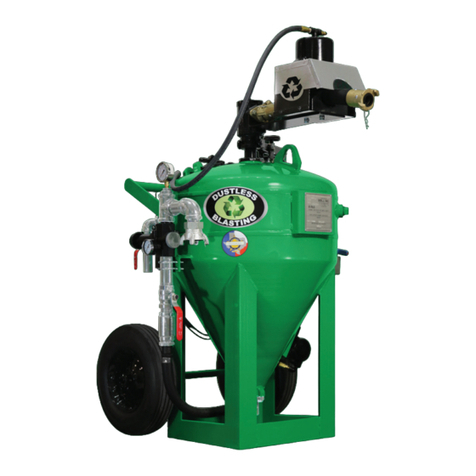
MMLJ MANUFACTURING
MMLJ MANUFACTURING DUSTLESS BLASTING DB500 user manual
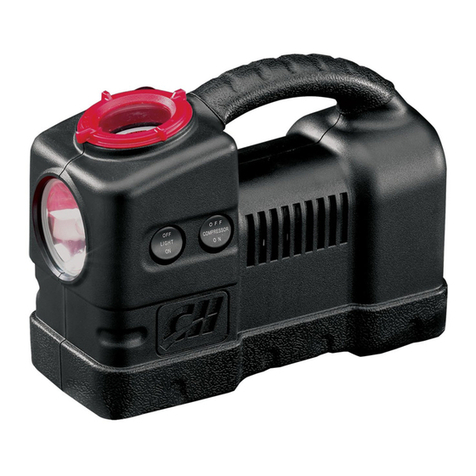
Campbell Hausfeld
Campbell Hausfeld RP3200 operating instructions

Westfalia
Westfalia 85 92 78 Original instructions
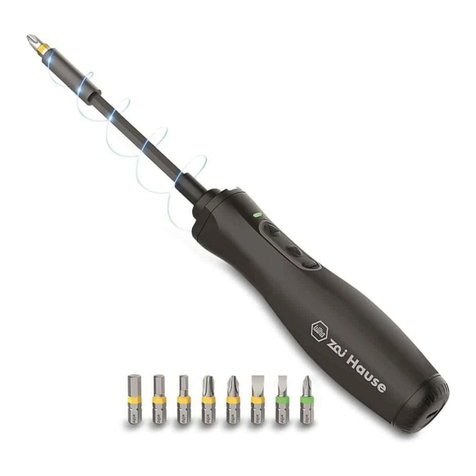
Wiha
Wiha DHT0001 instruction manual
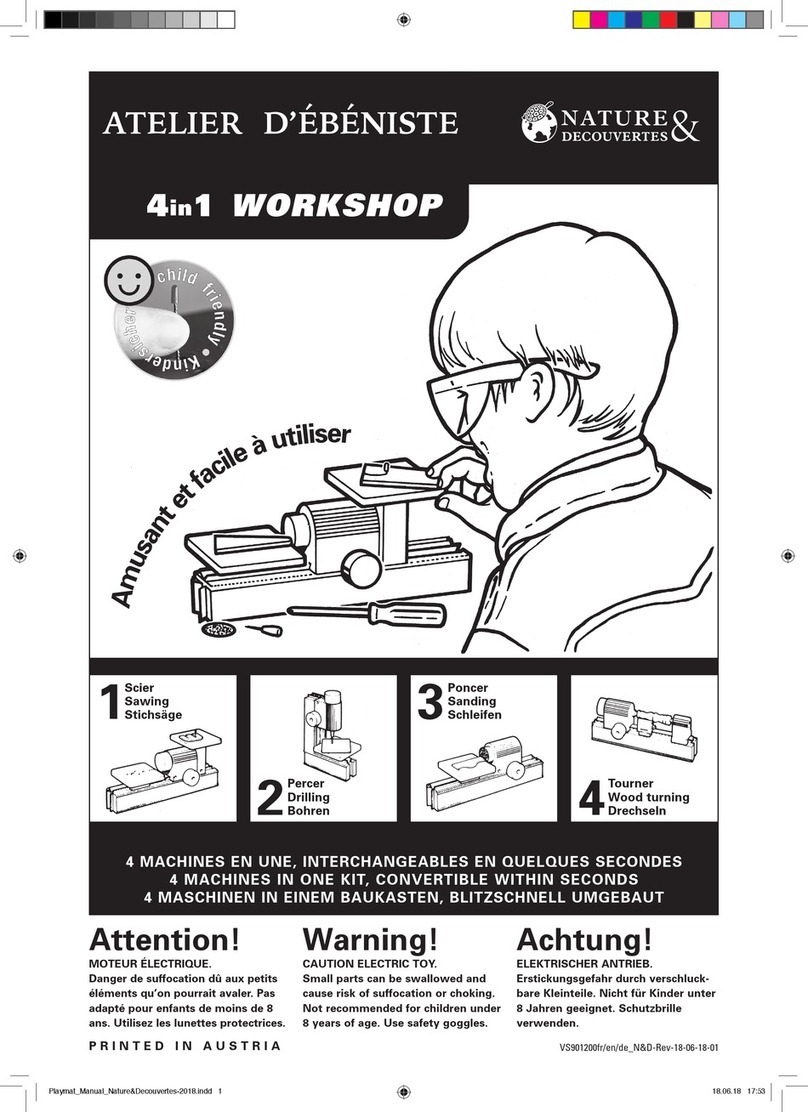
NATURE & DECOUVERTES
NATURE & DECOUVERTES ATELIER D'EBENISTE manual
